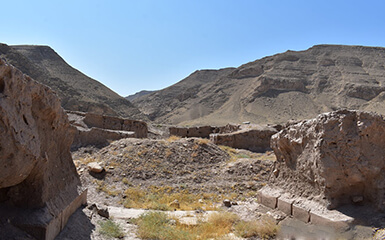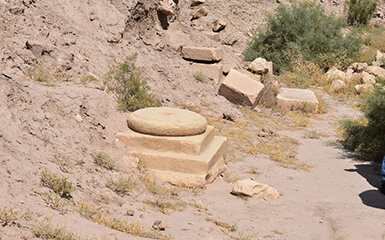Kok Gumbaz
Ajina Teppa
Ancient Panjakent
Anzob Tunnel
Beshkent Qala
Childukhtaron
Khazrati Shokh
Mug Teppa
Gharm Chashma
Hisor Historical
Haji Yaqub mosque
Hazrati-Bobo complex
Lake Iskanderkul
Kalai-Khumb
Karatag
Karon
Khishtin caravanserai
Khorog
Khulbuk
Lake Karakul
Abdullatif Sultan
Madrasai Kuhna
Abu Abdullah Rudaki
Khoja Mashhad
Khudoyor Valami
Makhmudi Azam
Mir Sayyid Ali Hamadani
Muhammed Bashoro
Sheikh Muslihiddin
Nurek Mountain Lake
Pamir
Sarazm
Sari-Khosor
Seven Lakes
Shirkent
Chiluchorchashma
Takht-i Sangin
Takht-i Sangin

Takht-i Sangin is an archaeological site in southern Tajikistan. It includes a fortification and a large temple known as the Oxus Temple. The complex was built in the 3rd century BC and has architectural, cultural and religious characteristics of the Persian Achaemenid Empire and the Greco-Bactrian Kingdom.
The site is located near the confluence of the Panj and Vakhsh rivers to the Amu Darya, one of the great rivers of Central Asia, which was called Oxus in ancient times. Takht-i Sangin being built on a rock platform above the river. This location explains the name of the site, which can be translated as rock platform or rock throne.
More than 5,000 individual finds were found during excavations on the site of Takht-i Sangin, many of which are now exhibited in the Tajik National Museum. These include coins from different eras as well as numerous weapons and works of art, especially made of ivory. Most of the works of art were statues, busts and reliefs in the Greek style, while most of the weapons found are of Achaemenid origin.
The centre of the complex is a citadel, in which the Oxus Temple was also located. The surrounding settlement extended in a radius of about one kilometre around the citadel. The traces of settlement indicate a right-angled network of paths in the city; the buildings outside the citadel mainly contain remains of foundations and columns. The walls of the citadel, which are up to three meters thick, enclose an area measuring 235 by 167 meters. The central building of the citadel was the Oxus Temple, which was built on a square base with a side length of 51 meters. The temple complex was laid out symmetrically with the main entrance in the east, which was designed as a portico with two rows of four columns each. The entrance to the temple complex led into an inner courtyard, at the western end of which was the spiritual centre of the complex. This extended over a square area of 32 meters on each side and consisted of a central chancel flanked by four smaller porticoed halls. In the architectural tradition of Zoroastrianism, the pillared halls of the Ateshgah (House of Fire), where an eternal flame burned.
The numerous columns of the complex were designed in the style of the Ionic order, while the built-in bricks and the construction of the wall show clear characteristics of Achaemenid architecture. The design of the temple complex indicates a syncretism of Hellenistic and Zoroastrian beliefs, which is already suggested by an ancient Greek inscription on a limestone altar in the Oxus Temple:
Atrosokes dedicates his vow to the Oxus
The name Atrosokes is of Zoroastrian origin, while the dedication to the Oxus, the ancient name of Amudarjas, indicates a water and river cult widespread in both Greek mythology and Zoroastrianism. Further traces of the Hellenistic influence are depictions of nymphs and other beings from Greek mythology, which were found on numerous finds from Takht-i Sangin.

